Environmental Groundwater Vulnerability Assessment in Urban Water Mines (Porto, NW Portugal)
Abstract
:1. Introduction
- (i)
- Understand the evolution of vulnerability to groundwater contamination in Porto city spring waters throughout the last century in a hydrogeo-historical perspective. In addition, to compare several vulnerability methods using different parameters in order to estimate their efficiency in this case study and to be able to generalize this vulnerability assessment for other urban groundwater scenarios;
- (ii)
- Check the role in an integrated approach for surface and subsurface potential contamination sources and groundwater isotopic data on the validation of vulnerability to contamination;
- (iii)
- Develop a seasonal ecotoxicological characterisation of the groundwater, for hazard assessment and compliance with EU Groundwater Directive 2006/118/EC;
- (iv)
- Illustrate the importance of groundwater studies as a key-issue to tackle in large urban areas and also to contribute to the development of urban hydrogeology conceptual models.
2. Porto Urban Area: Paranhos and Salgueiros Spring Waters
3. Materials and Methods
3.1. Land Use Mapping and Inventory of Water Features
3.2. Geodata Information Sources
3.3. Inventory of Potential Contamination Sources
3.4. Hydrogeochemistry, Isotope Tracers
3.5. Vulnerability Assessment
3.6. Acute Effects of Ecotoxicological Evaluation
4. Results and Discussion
4.1. Land Use Mapping and Water Features Inventory
4.2. Inventory of Potential Contamination Sources
4.3. Hydrogeochemistry and Isotope Tracers
4.4. Groundwater Vulnerability Assessment
4.5. Groundwater Ecotoxicology
5. Urban Hydrogeological Conceptual Model
6. Conclusions
Supplementary Materials
Acknowledgments
Author Contributions
Conflicts of Interest
References
- Lerner, D.N.; Barrett, M.H. Urban groundwater issues in the United Kingdom. Hydrogeol. J. 1996, 4, 80–89. [Google Scholar] [CrossRef]
- Lerner, D.N. Identifying and quantifying urban recharge: A review. Hydrogeol. J. 2002, 10, 143–152. [Google Scholar] [CrossRef]
- Vázquez-Suñé, E.; Sánchez-Vila, X.; Carrera, J. Introductory review of specific factors influencing urban groundwater, an emerging branch of hydrogeology, with reference to Barcelona, Spain. Hydrogeol. J. 2005, 13, 522–533. [Google Scholar] [CrossRef]
- National Research Council (NRC). Ground Water Recharge Using Waters of Impaired Quality; National Academy Press: Washington, DC, USA, 1994. [Google Scholar]
- Foster, S.D.; Hirata, R.; Howard, K.W.F. Groundwater use in developing cities: Policy issues arising from current trends. Hydrogeol. J. 2011, 19, 271–274. [Google Scholar] [CrossRef]
- Afonso, M.J.; Chaminé, H.I.; Marques, J.M.; Carreira, P.M.; Guimarães, L.; Guilhermino, L.; Gomes, A.; Fonseca, P.E.; Pires, A.; Rocha, F. Environmental issues in urban groundwater systems: A multidisciplinary study of the Paranhos and Salgueiros spring. Environ. Earth Sci. 2010, 61, 379–392. [Google Scholar] [CrossRef]
- Afonso, M.J.; Pires, A.; Chaminé, H.I.; Marques, J.M.; Guimarães, L.; Guilhermino, L.; Rocha, F. Aquifer vulnerability assessment of urban areas using a GIS-based cartography: Paranhos groundwater pilot site, Porto, NW Portugal. In Global Groundwater Resources and Management; Paliwal, B.S., Ed.; Scientific Publishers: Jodhpur, India, 2010; pp. 259–278. [Google Scholar]
- Vrba, J.; Zaporozec, A. Guidebook on Mapping Groundwater Vulnerability; IAH, International Contributions to Hydrogeology, 16; Verlag Heinz Heise: Hannover, Germany, 1994. [Google Scholar]
- Gogu, R.C.; Dassargues, A. Current trends and future challenges in groundwater vulnerability assessment using overlay and index methods. Environ. Geol. 2000, 39, 549–559. [Google Scholar] [CrossRef]
- Vrba, J.; Lipponen, A. Groundwater Resources Sustainability Indicators; UNESCO, IHP-VI, Series on Groundwater, 14; UNESCO: Paris, France, 2007. [Google Scholar]
- Witkowski, A.; Kowalczyk, A.; Vrba, J. Groundwater Vulnerability Assessment and Mapping; International Association of Hydrogeologists Selected Papers SP11; Taylor & Francis Group: London, UK, 2007. [Google Scholar]
- Pisinaras, V.; Polychronis, C.; Gemitzi, A. Intrinsic groundwater vulnerability determination at the aquifer scale: A methodology coupling travel time estimation and rating methods. Environ. Earth Sci. 2007, 75, 85. [Google Scholar] [CrossRef]
- Kazemi, G.; Lehr, J.; Perrochet, P. Groundwater Age; John Wiley & Sons: New York, NY, USA, 2006. [Google Scholar]
- Attard, G.; Rossier, Y.; Eisenlohr, L. Urban groundwater age modeling under unconfined condition—Impact of underground structures on groundwater age: Evidence of a piston effect. J. Hydrol. 2016, 535, 652–661. [Google Scholar] [CrossRef]
- Mays, L.W. Groundwater resources sustainability: Past, present, and future. Water Resour. Manag. 2013, 27, 4409–4424. [Google Scholar] [CrossRef]
- Foster, S.; Evans, R.; Escolero, O. The groundwater management plan: In praise of a neglected ‘tool of our trade’. Hydrogeol. J. 2015, 23, 847–850. [Google Scholar] [CrossRef]
- Plummer, R.; Loë, R.; Armitage, D. A systematic review of water vulnerability assessment tools. Water Resour. Manag. 2012, 26, 4327–4346. [Google Scholar] [CrossRef]
- Liggett, J.E.; Talwar, S. Groundwater vulnerability assessments and integrated water resource management. Streamline Watershed Manag. Bull. 2009, 13, 18–29. [Google Scholar]
- Schirmer, M.; Leschik, S.; Musolff, A. Current research in urban hydrogeology: A review. Adv. Water Resour. 2013, 51, 280–291. [Google Scholar] [CrossRef]
- Zektser, I.S.; Everett, L.G. Groundwater Resources of the World and Their Use; UNESCO, IHP-VI, Series on Groundwater, 6; UNESCO: Paris, France, 2004. [Google Scholar]
- Civita, M.V. The combined approach when assessing and mapping groundwater vulnerability to contamination. J. Water Resour. Prot. 2010, 2, 14–28. [Google Scholar] [CrossRef]
- Foster, S.D.; Hirata, R.; Andreo, B. The aquifer pollution vulnerability concept: Aid or impediment in promoting groundwater protection? Hydrogeol. J. 2013, 21, 1389–1392. [Google Scholar] [CrossRef]
- Junior, R.F.; Varandas, S.G.P.; Fernandes, L.F.S. Multicriteria analysis for the monitoring of aquifer vulnerability: A scientific tool in environmental policy. Environ. Sci. Policy 2015, 48, 250–264. [Google Scholar] [CrossRef]
- Chaminé, H.I.; Teixeira, J.; Freitas, L.; Pires, A.; Silva, R.S.; Pinho, T.; Monteiro, R.; Costa, A.L.; Abreu, T.; Trigo, J.F.; et al. From engineering geosciences mapping towards sustainable urban planning. Eur. Geol. J. 2016, 41, 16–25. [Google Scholar]
- De Oliveira Marques, A.H. History of Portugal, from Lusitania to Empire; Columbia University Press: New York, NY, USA, 1972; Volume 1. [Google Scholar]
- Afonso, M.J. Hidrogeologia de rochas graníticas da região do Porto (NW de Portugal). Cadernos Laboratorio Xeolóxico Laxe 2003, 28, 173–192. [Google Scholar]
- Afonso, M.J.; Marques, J.M.; Guimarães, L.; Costa, I.; Teixeira, J.; Seabra, C.; Rocha, F.; Guilhermino, L.; Chaminé, H.I. Urban hydrogeology of the Paranhos sector, Porto city (NW Portugal): A geoenvironmental perspective. In Aquifer Systems Management: Darcy’s Legacy in a World of Impending Water Shortage; Chery, L., Marsily, G., Eds.; Selected Papers on Hydrogeology; IAH/Taylor & Francis CRC Press: London, UK, 2007; SP10; pp. 391–406. [Google Scholar]
- Afonso, M.J. Hidrogeologia e Hidrogeoquímica da Região Litoral Urbana do Porto, Entre Vila do Conde e Vila Nova de Gaia (NW de Portugal): Implicações Geoambientais. Ph.D. Thesis, Universidade Técnica de Lisboa, Lisbon, Portugal.
- COBA—Consultores de Engenharia e Ambiente, SA. Carta Geotécnica do Porto, 2nd ed.; COBA/FCUP/CMP: Porto, Portugal, 2003. [Google Scholar]
- Von Eschwege, W.L. Geognostische Verhältnisse der Gegend von Porto, nebst einer Beschreibung des bei S. Pedro da Cova gelegenen Steinkohlenlagers, welches die Uebergangsbildung von der Urbildung trennt. Arch. Miner. Geognos Bergbau Hüttenkd 1833, 6, 264–276. [Google Scholar]
- Sharpe, D. On the geology of the neighbourhood of OPorto, including the Silurian coal and slates of Vallongo. Q. J. Geol. Soc. Lond. Proc. 1849, 5, 142–153. [Google Scholar] [CrossRef]
- Carríngton da Costa, J. O Pôrto: Geografia-Geologia; Bastos, C., Ed.; Nova Monografia do Porto, Companhia Portuguesa do Porto: Porto, Portugal, 1938; pp. 3–32. [Google Scholar]
- Montenegro de Andrade, M. O “Granito do Porto”: Síntese, crítica e novos elementos para o seu conhecimento. In Sumários, IV Reunião de Geologia do Oeste Peninsular; Salamanca-Coimbra: Porto, Portugal, 1976; 2p. [Google Scholar]
- Chaminé, H.I.; Gama Pereira, L.C.; Fonseca, P.E.; Noronha, F.; Lemos de Sousa, M.J. Tectonoestratigrafia da faixa de cisalhamento de Porto–Albergaria-a-Velha–Coimbra–Tomar, entre as Zonas Centro-Ibérica e de Ossa-Morena (Maciço Ibérico, W de Portugal). Cadernos Laboratório Xeolóxico Laxe 2003, 28, 37–78. [Google Scholar]
- Almeida, A. Geology and urban landscape: The granite in Oporto, NW Portugal. Eur. Geol. J. 2006, 21, 4–8. [Google Scholar]
- Rosas da Silva, D.J. Depósitos de evansite nos granitos do Porto (Portugal). Anais Faculdade Ciências Pôrto 1935, 19, 1–8. [Google Scholar]
- Sanchez-Moral, S.; Fernandez-Cortes, A.; Cuezva, S.; Cañaveras, J.C.; Correcher, V.; Miller, A.Z.; Dionisio, A.; Marques, J.M.; Saiz-Jimenez, C.; Afonso, M.J.; et al. Uranyl-evansites from Porto (NW Portugal) and Galicia (NW Spain): Structure and assignment of spectra catholuminescence and raman bands. Spectrosc. Lett. 2011, 44, 511–515. [Google Scholar] [CrossRef]
- Begonha, A.; Sequeira Braga, M.A. Weathering of the Oporto granite: Geotechnical and physical properties. Catena 2002, 49, 57–76. [Google Scholar] [CrossRef]
- Fontes, A. Contribuição Para a Hygiene do Porto: Analyse Sanitaria do seu Abastecimento em Água Potável. I. Estudo dos Mananciaes de Paranhos e Salgueiros. Bachelor’s Thesis, Escola Médico-Cirúrgica do Porto, Porto, Portugal, 1908. [Google Scholar]
- Chaminé, H.I.; Afonso, M.J.; Robalo, P.M.; Rodrigues, P.; Cortez, C.; Monteiro Santos, F.A.; Plancha, J.P.; Fonseca, P.E.; Gomes, A.; Devy-Vareta, N.F.; et al. Urban speleology applied to groundwater and geo-engineering studies: Underground topographic surveying of the ancient Arca D’Água galleries catchworks (Porto, NW Portugal). Int. J. Speleol. 2010, 39, 1–14. [Google Scholar] [CrossRef]
- Chaminé, H.I.; Afonso, M.J.; Freitas, L. From historical hydrogeological inventory through GIS mapping to problem solving in urban groundwater systems. Eur. Geol. J. 2014, 38, 33–39. [Google Scholar]
- Freitas, L.; Afonso, M.J.; Devy-Vareta, N.; Marques, J.M.; Gomes, A.; Chaminé, H.I. Coupling hydrotoponymy and GIS cartography: A case study of hydro-historical issues in urban groundwater systems, Porto, NW Portugal. Geogr. Res. 2014, 52, 182–197. [Google Scholar] [CrossRef]
- European Environment Agency (EEA). CLC2006 Technical Guidelines: Update of Corine Land Cover (CLC) for the Reference Year 2006; European Environment Agency: Copenhagen, Denmark, 2007. [Google Scholar]
- Telles Ferreira, A.G. Carta Topográfica da Cidade do Porto; Direcção-Geral dos Trabalhos Geodésicos, Topográficos, Hidrográficos e Geológicos do Reino: Lisboa, Portugal, 1892. [Google Scholar]
- Madureira, H. Processos de transformação da estrutura verde do Porto. Geografia 2001–2002, 17–18, 137–218. [Google Scholar]
- Madureira, H.; Andresen, T.; Monteiro, A. Green structure and planning evolution in Porto. Urban For. Urban Green. 2011, 10, 141–149. [Google Scholar] [CrossRef]
- International Society for Rock Mechanics (ISRM). Basic geotechnical description of rock masses. Int. J. Rock Mech. Min. Sci. 1981, 18, 85–110. [Google Scholar]
- Struckmeier, W.F.; Margat, J. Hydrogeological Maps: A Guide and a Standard Legend; IAH International Contributions to Hydrogeology; Verlag Heinz Heise: Hannover, Germany, 1995. [Google Scholar]
- Committee on Fracture Characterization and Fluid Flow (CFCFF). Rock Fractures and Fluid Flow: Contemporary Understanding and Applications; National Academy Press: Washington, DC, USA, 1996. [Google Scholar]
- Assaad, F.A.; LaMoreaux, P.E.; Hughes, T.H.; Wangfang, Z.; Jordan, H. Field Methods for Geologists and Hydrogeologists; Springer: Berlin/Heidelberg, Germany, 2004. [Google Scholar]
- Zaporozec, A. (Ed.) Groundwater Contamination Inventory: A Methodological Guide with a Model Legend for Groundwater Contamination Inventory and Risk Maps; UNESCO, IHP-VI, Series on Groundwater, 2; UNESCO: Paris, France, 2004.
- Giesemann, A.; Jaeger, H.J.; Norman, A.-L.; Krouse, H.R.; Brand, W.A. On-line sulfur-isotope determination using an elemental analyzer coupled to a mass spectrometer. Anal. Chem. 1994, 66, 2816–2819. [Google Scholar] [CrossRef]
- Mayer, B.; Krouse, H.R. Procedures for sulfur isotope abundance studies. In Handbook of Stable Isotope Analytical Techniques; De Groot, P., Ed.; Elsevier: Amsterdam, The Netherlands, 2004; pp. 538–596. [Google Scholar]
- American Society for Testing and Materials (ASTM). Standard Test Method for Radon in Drinking Water; ASTM-D5072-09(2016); ASTM International: Philadelphia, PA, USA, 2016. [Google Scholar]
- Forte, M.; Rusconi, R.; Badalamenti, P.; Bellinzona, S.; Gollini, R.; Maltese, S.; Romeo, C.; Sgorbati, G. The monitoring of tap waters in Milan: Planning methods and results. Radiat. Prot. Dosim. 2004, 111, 373–376. [Google Scholar]
- Gonçalves, C.V.M.; Pereira, A.J.S.C. Radionuclides in groundwater of the Serra do Buçaco region (Portugal). In Groundwater and Ecosystems: Lisbon 2007: Proceedings: XXXV IAH Congress, International Association of Hydrogeologists, CD-Rom ed.; Ribeiro, L., Chambel, A., Condesso de Melo, M.T., Eds.; IAH: Lisbon, Portugal, 2007; 9p. [Google Scholar]
- Van Stempvoort, D.; Evert, L.; Wassenaar, L. Aquifer vulnerability index: A GIS compatible method for groundwater vulnerability mapping. Can. Water Resour. J. 1993, 18, 25–37. [Google Scholar] [CrossRef]
- Foster, S.D. Fundamental concepts in aquifer vulnerability, pollution risk and protection strategy. In Vulnerability of Soil and Groundwater to Pollutants, Proceedings and Information; Duijvenbooden, W., van Waegeningh, H.G., Eds.; TNO Committee on Hydrological Research: The Hague, The Netherlands, 1987; Volume 38, pp. 69–86. [Google Scholar]
- Foster, S.D.; Hirata, R. Groundwater Pollution Risk Assessment: A Methodology Using Available Data; WHO-PAHO/HPE-CEPIS Technical Manual; Pan American Center for Sanitary Engineering and Environmental Sciences: Lima, Peru, 1988. [Google Scholar]
- Foster, S.D.; Hirata, R.; Gomes, D.; D’Elia, M.; Paris, M. Groundwater Quality Protection: A Guide for Water Utilities, Municipal Authorities, and Environment Agencies; The World Bank: Washington, DC, USA, 2002. [Google Scholar]
- Aller, L.; Bennet, T.; Lehr, J.H.; Petty, R.J. DRASTIC: A Standardised System for Evaluating Groundwater Pollution Potential Using Hydrologic Settings; US EPA Report, 600/2-87/035; Robert S. Kerr Environmental Research Laboratory: Ada, OK, USA, 1987. [Google Scholar]
- Denny, S.C.; Allen, D.N.; Journeay, J.M. DRASTIC-Fm: A modified vulnerability mapping method for structurally controlled aquifers in the southern Gulf Islands, British Columbia, Canada. Hydrogeol. J. 2007, 15, 483–493. [Google Scholar] [CrossRef]
- Civita, M.V. Le Carte Della Vulnerabilità degli Acquiferi All’inquinamento: Teoria & Pratica; Pitagora Editrice: Bologna, Italy, 1994. [Google Scholar]
- Civita, M.V.; De Maio, M. Valutazione e Cartografia Automatica della Vulnerabilità Degli Acquiferi All’inquinamento Con il Sistema Parametrico: SINTACS R5; Pitagora Editrice: Bologna, Italy, 2000. [Google Scholar]
- Organisation for Economic Co-operation and Development (OECD). OECD Guidelines for Testing of Chemicals, Revised Protocol for Updating Guideline 202, Daphnia sp.; Acute Immobilisation Test; OECD: Paris, France, 2004. [Google Scholar]
- Baird, D.J.; Barber, I.; Bradley, M.; Calow, L.; Soares, A.M.V.M. The Daphnia bioassay: A critique. Hydrobiologia 1989, 188/189, 403–406. [Google Scholar] [CrossRef]
- American Society for Testing and Materials (ASTM). Standard Practice for Conducting Acute Toxicity Tests with Fishes; Macroinvertebrates and Amphibians; ASTM E729-96(2014); ASTM International: Philadelphia, PA, USA, 2014. [Google Scholar]
- Baird, D.J.; Soares, A.M.V.M.; Girling, A.; Barber, I.; Bradley, M.; Callow, P. The long-term maintenance of Daphnia magna Straus for use in ecotoxicity tests: Problems and prospects. In Proceedings First European Conference on Ecotoxicology; Løkke, H., Tyle, H., Bro-Rasmussen, F., Eds.; Danish Ministry of Environment: Lyngby, Denmark, 1989; pp. 144–148. [Google Scholar]
- Carteado Mena, J. Contribuição Para o Estudo da Hygiene do Porto: Analyse Sanitaria do seu Abastecimento em Água Potável. III. Estudo Sobre os Poços do Porto; Unpublished Report; Laboratório de Bacteriologia do Porto e Laboratório de Hygiene do Porto: Porto, Portugal, 1908. (In Portuguese) [Google Scholar]
- Bahia Junior, J. Contribuição Para a Hygiene do Porto: Analyse Sanitaria do seu Abastecimento em Agua Potavel. Porto: II—Mananciaes do Campo Grande, Bispo e Freiras, Cavaca, Camões, Virtudes, Fontaínhas, Praça do Marquês de Pombal e Burgal: Fontes suas Derivadas de Nascente Privativa. Bachelor’s Thesis, Escola Médico-Cirúrgica do Porto, Porto, Portugal, 1909. [Google Scholar]
- Attard, G.; Winiarski, T.; Rossier, Y.; Eisenlohr, L. Review: Impact of underground structures on the flow of urban groundwater. Hydrogeol. J. 2016, 24, 5–19. [Google Scholar] [CrossRef]
- Krouse, H.R.; Mayer, B. Sulphur and oxygen isotopes in sulphate. In Environmental Tracers in Subsurface Hydrogeology, 2nd ed.; Cook, P., Herczeg, A.L., Eds.; Kluwer Academic Publishers: Boston, MA, USA, 2001; pp. 195–231. [Google Scholar]
- Hosono, T.; Nakano, T.; Igeta, A.; Tayasu, I.; Tanaka, T.; Yachi, S. Impact of fertilizer on a small watershed of Lake Biwa: Use of sulfur and strontium isotopes in environmental diagnosis. Sci. Total Environ. 2007, 384, 342–354. [Google Scholar] [CrossRef] [PubMed]
- Pauwels, H.; Ayraud-Vergnaud, V.; Aquilina, L.; Molénat, J. The fate of nitrogen and sulfur in hard-rock aquifers as shown by sulfate-isotope tracing. Appl. Geochem. 2010, 25, 105–115. [Google Scholar] [CrossRef]
- Desideri, D.; Meli, M.A.; Feduzi, L.; Roselli, C.; Rongoni, A.; Saetta, D. 238U, 234U, 226Ra, 210Po concentrations of bottled mineral waters in Italy and their dose contribution. J. Environ. Radioact. 2007, 94, 86–97. [Google Scholar] [CrossRef] [PubMed]
- Fan, K.; Kuo, T.; Han, Y.; Chen, C.; Lin, C.; Lee, C. Radon distribution in a gasoline-contaminated aquifer. Radiat. Meas. 2007, 42, 479–485. [Google Scholar] [CrossRef]
- Galhardi, J.A.; Bonotto, D.M. Radon in groundwater contaminated by dissolved hydrocarbons in Santa Bárbara d’Oeste, São Paulo State, Brazil. Appl. Radiat. Isot. 2012, 70, 2507–2515. [Google Scholar] [CrossRef] [PubMed]
- Pereira, A.J.S.C.; Godinho, M.M.; Neves, L.J.P.F. On the influence of faulting on small-scale soil-gas radon variability: A case study in the Iberian Uranium Province. J. Environ. Radioact. 2010, 101, 875–882. [Google Scholar] [CrossRef] [PubMed]
- Skeppström, K.; Olofsson, B. Uranium and radon in groundwater: An overview of the problem. Eur. Water 2007, 17/18, 51–62. [Google Scholar]
- Miller, A.Z.; Dionísio, A.; Sequeira Braga, M.A.; Hernández-Mariné, M.; Afonso, M.J.; Muralha, V.S.F.; Herrera, L.K.; Raabe, J.; Fernandez-Cortes, A.; Cuezva, S.; et al. Biogenic Mn oxide minerals coating in a subsurface granite environment. Chem. Geol. 2012, 322/323, 181–191. [Google Scholar] [CrossRef]
- Ferris, F.G.; Hallberg, R.O.; Lyvén, B.; Pedersen, K. Retention of strontium, cesium, lead and uranium by bacterial iron oxides from a subterranean environment. Appl. Geochem. 2000, 15, 1035–1042. [Google Scholar] [CrossRef]
- Miller, A.Z.; Hernández-Mariné, M.; Jurado, V.; Dionísio, A.; Barquinha, P.; Fortunato, E.; Afonso, M.J.; Chaminé, H.I.; Saiz-Jimenez, C. Enigmatic reticulated filaments in subsurface granite. Environ. Microbiol. Rep. 2012, 4, 596–603. [Google Scholar] [CrossRef] [PubMed]
- Speirs, L.; Nittami, T.; McIlroy, S.; Schroeder, S.; Seviour, R.J. Filamentous bacterium Eikelboom type 0092 in activated sludge plants in Australia is a member of the phylum Chloroflexi. Appl. Environ. Microbiol. 2009, 75, 2446–2452. [Google Scholar] [CrossRef] [PubMed]
- Jurado, V.; Laiz, L.; Rodriguez-Nava, V.; Boiron, P.; Hermosin, B.; Sanchez-Moral, S.; Saiz-Jimenez, C. Pathogenic and opportunistic microorganisms in caves. Int. J. Speleol. 2010, 39, 15–24. [Google Scholar] [CrossRef]
- Scott, G.; Crunkilton, R.L. Acute and chronic toxicity of nitrate to fathead minnows (Pimephales promelas), Ceriodaphnia dubia, and Daphnia Magna. Environ. Toxicol. Chem. 2000, 19, 2918–2922. [Google Scholar] [CrossRef]
- Hagger, J.A.; Jones, M.B.; Lowe, D.; Leonard, D.R.P.; Owen, R.; Galloway, T.S. Application of biomarkers for improving risk assessments of chemicals under the Water Framework Directive: A case study. Mar. Pollut. Bull. 2008, 56, 1111–1118. [Google Scholar] [CrossRef] [PubMed]

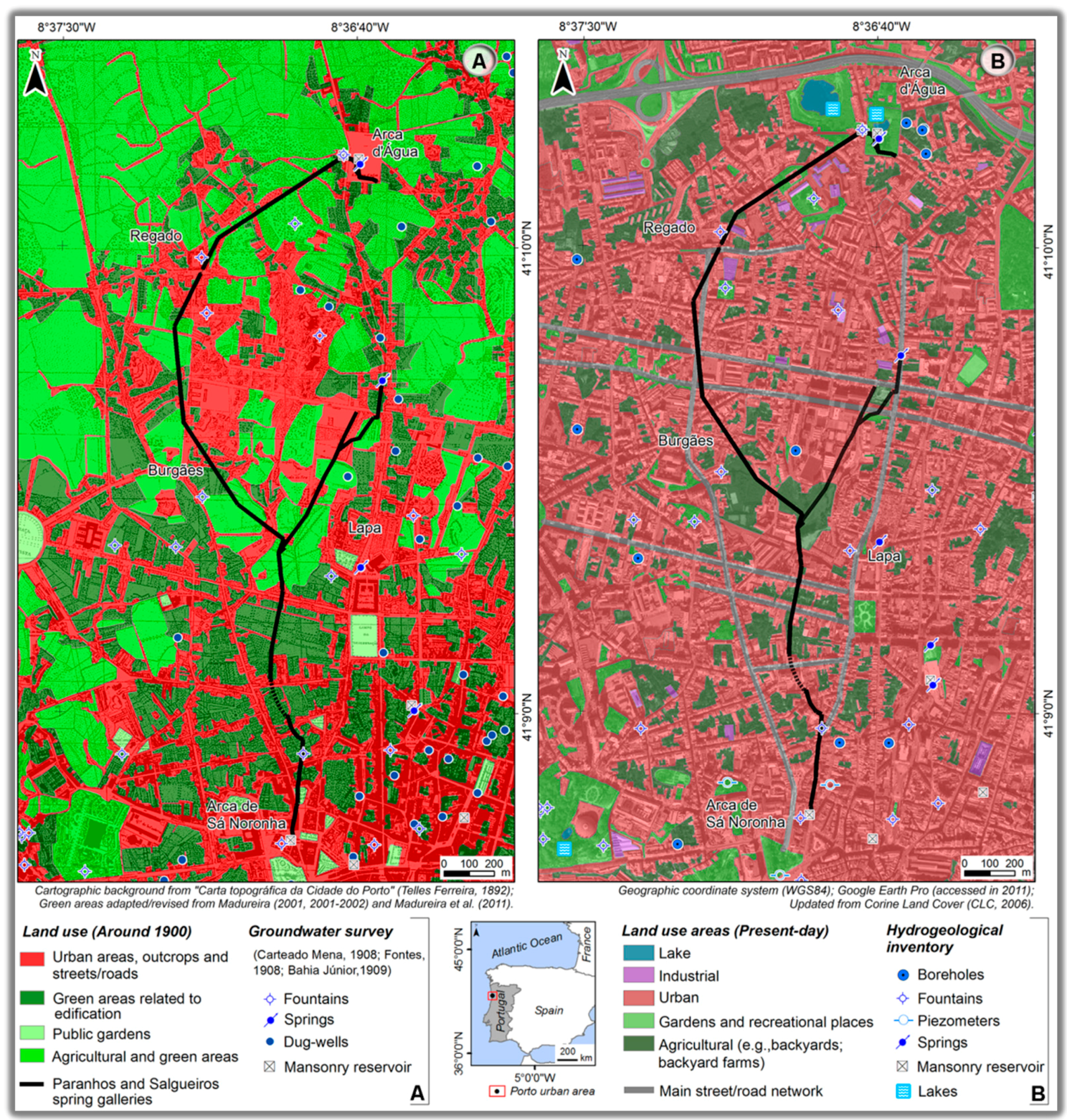
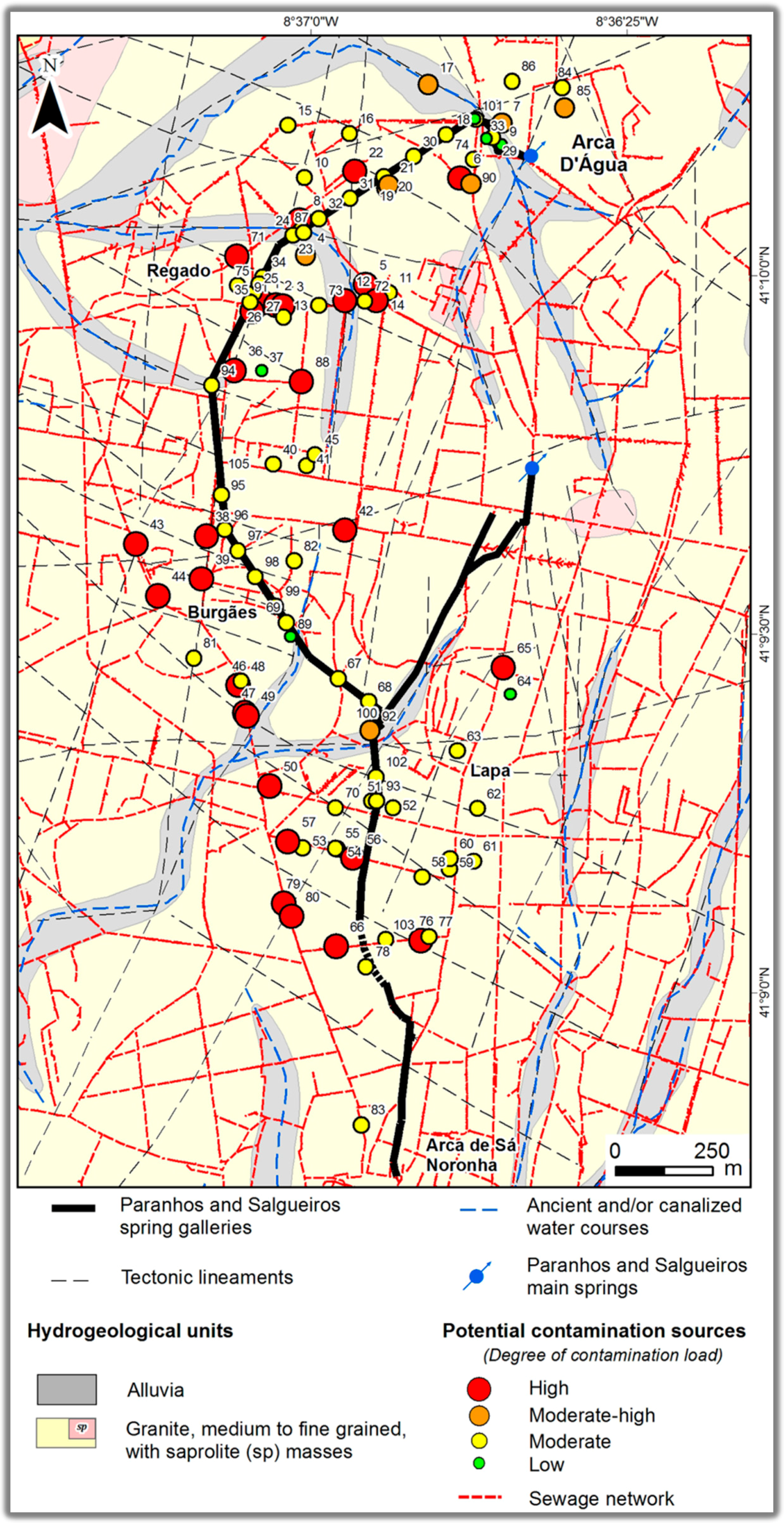

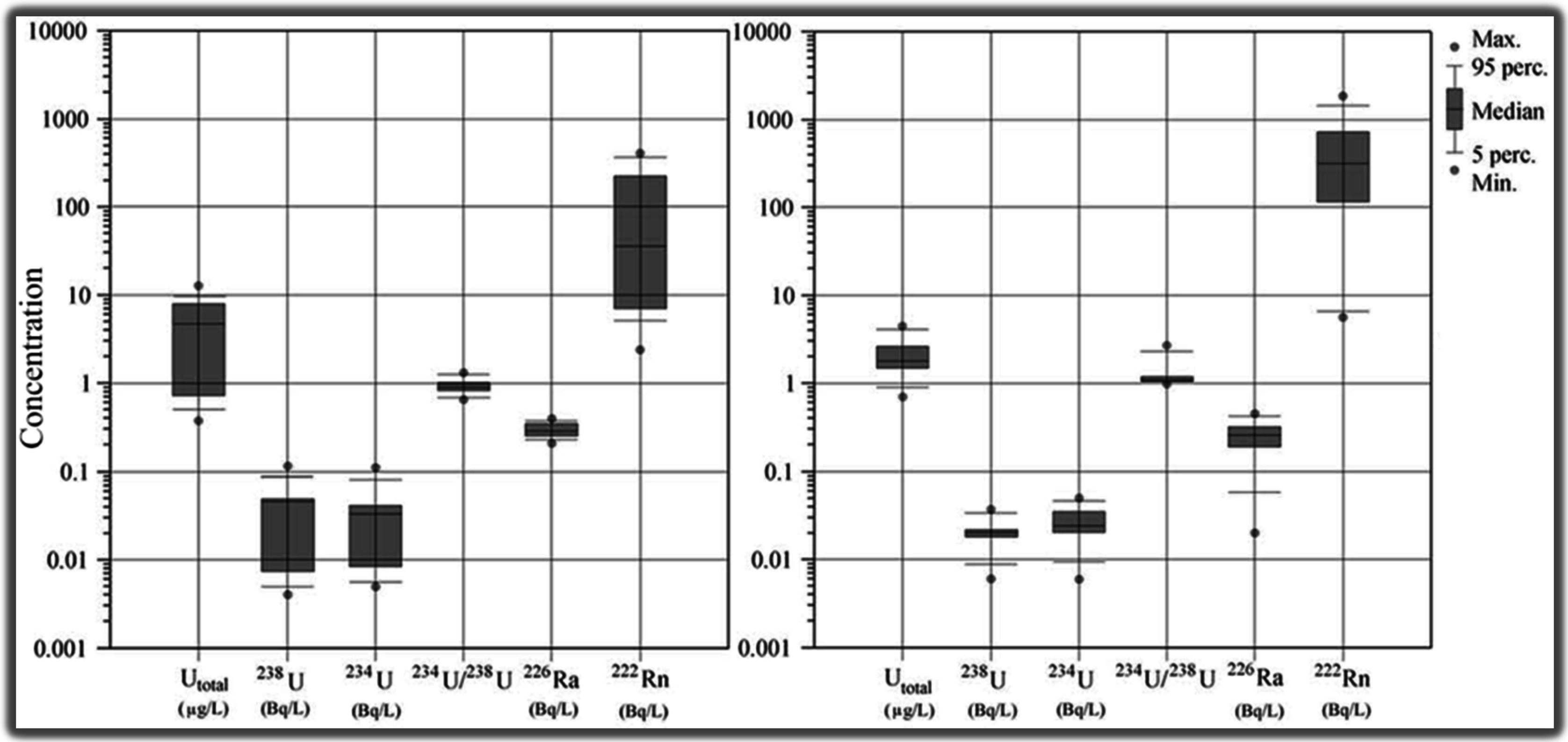
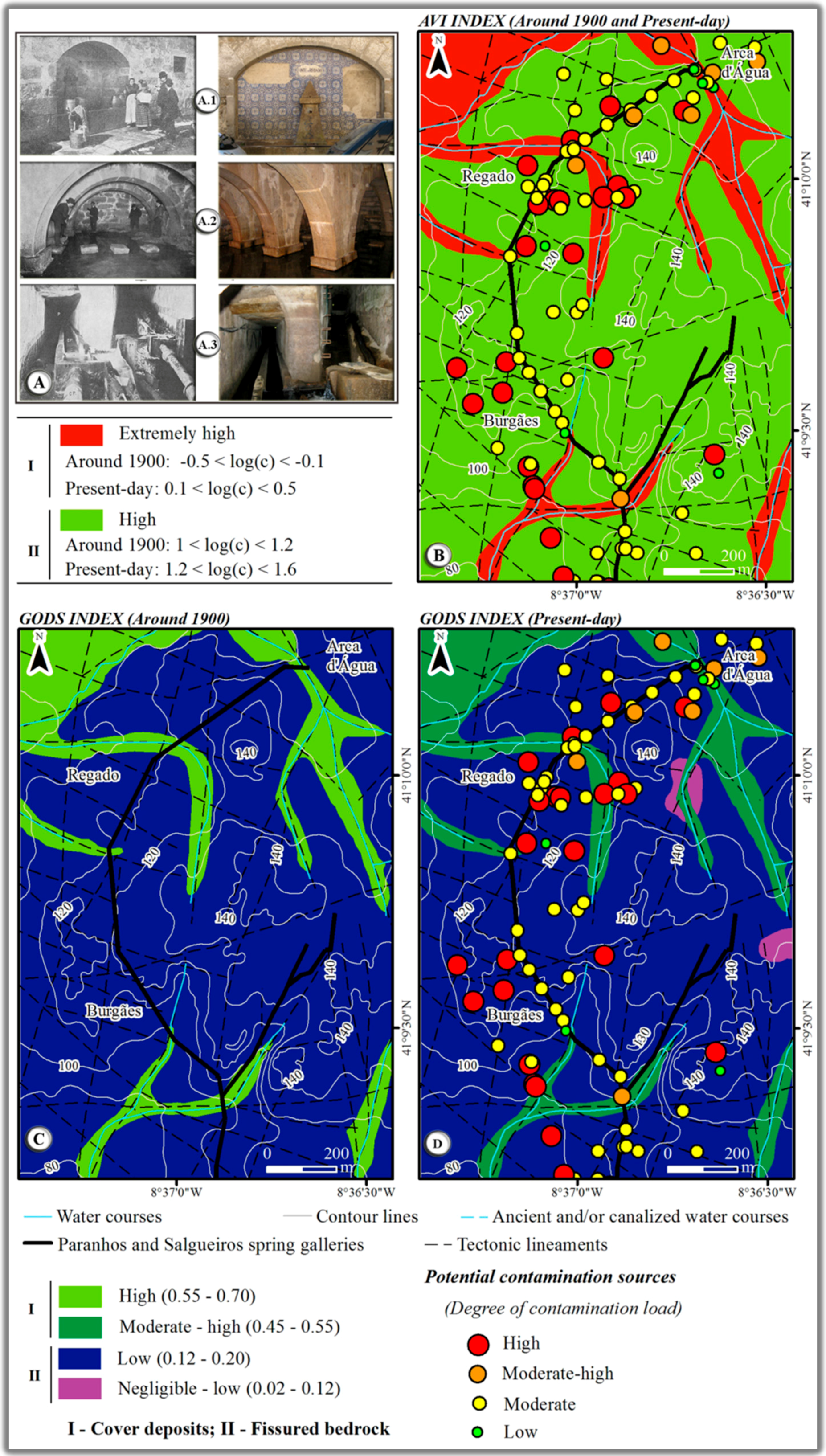
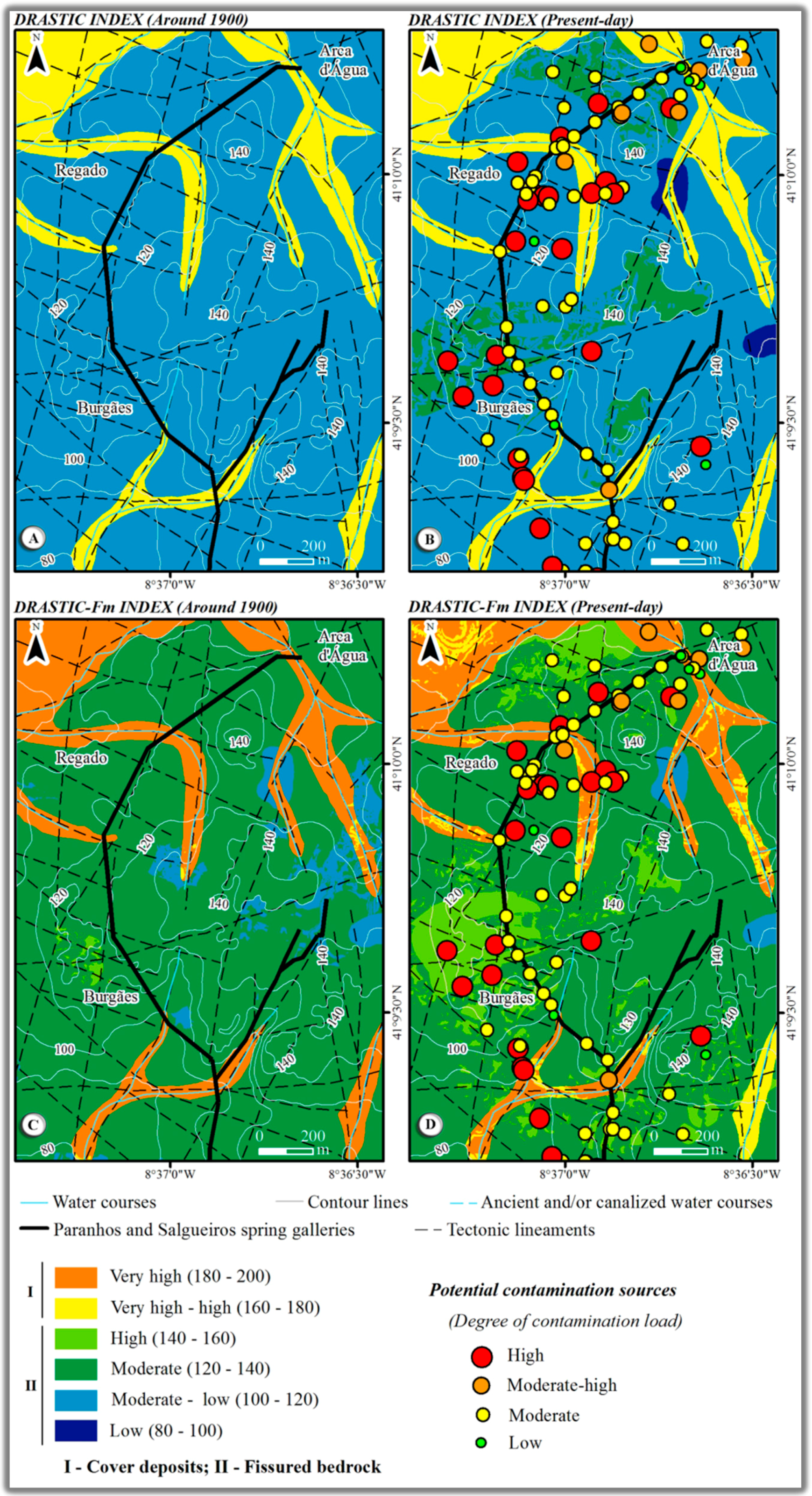
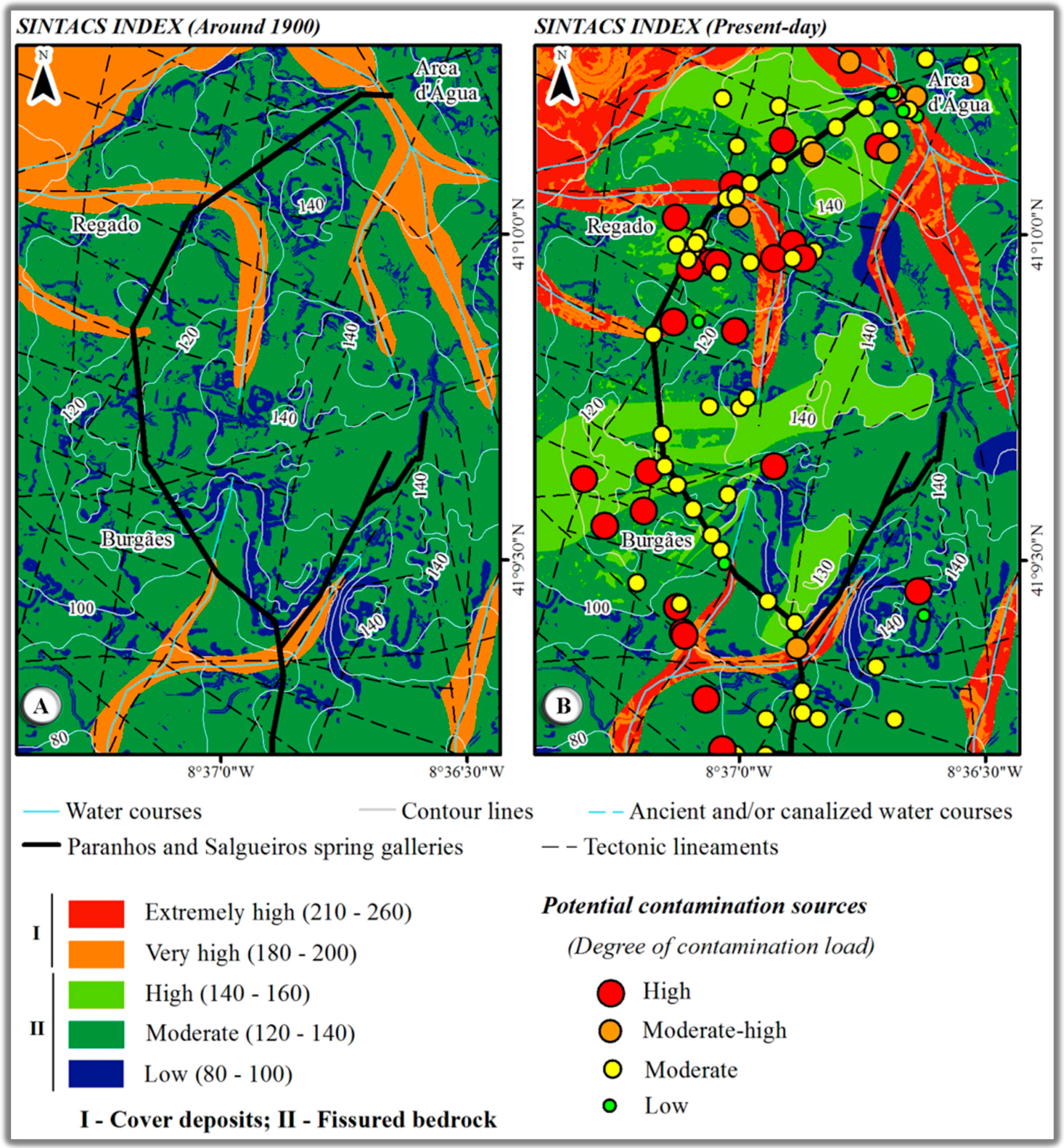
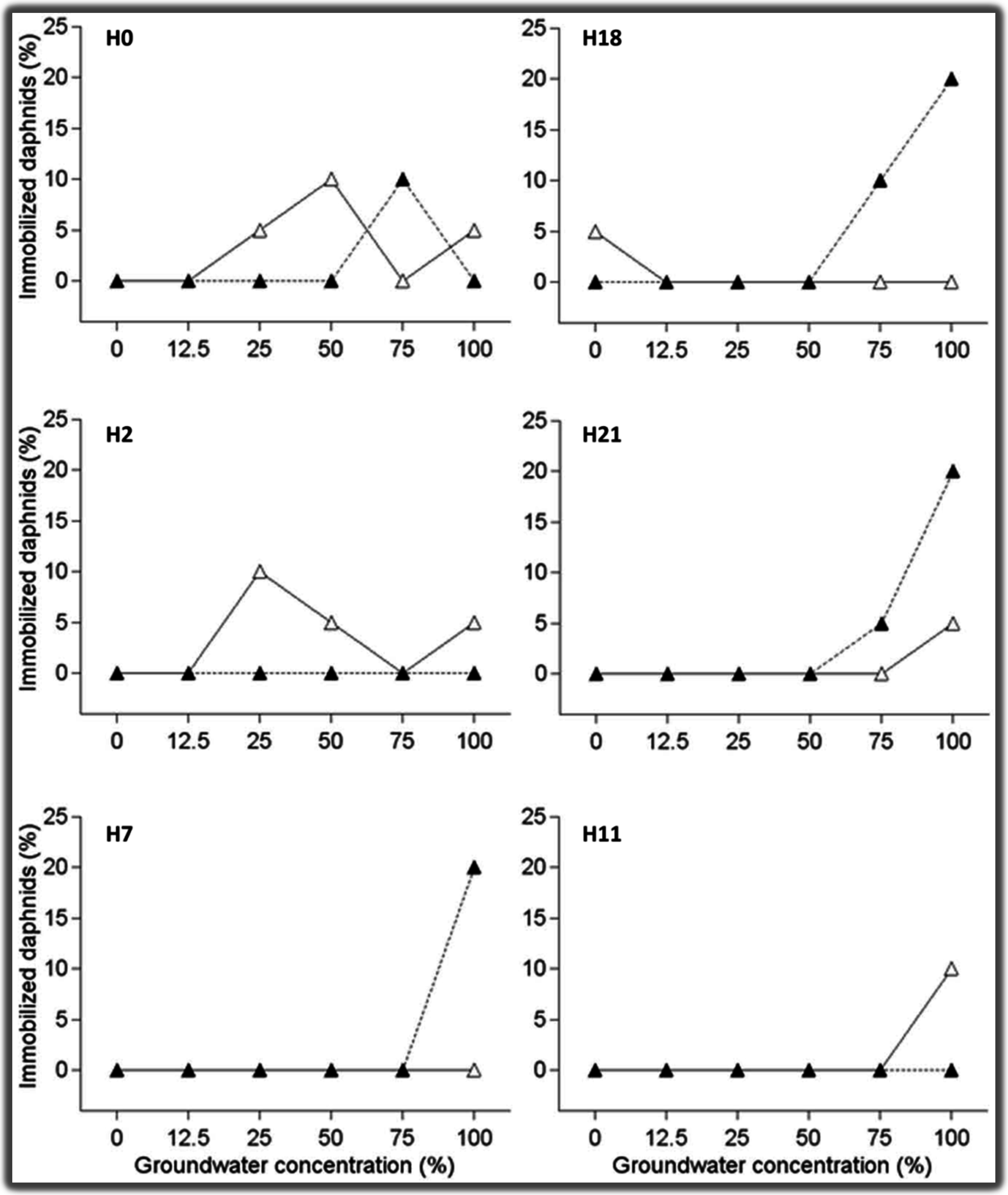
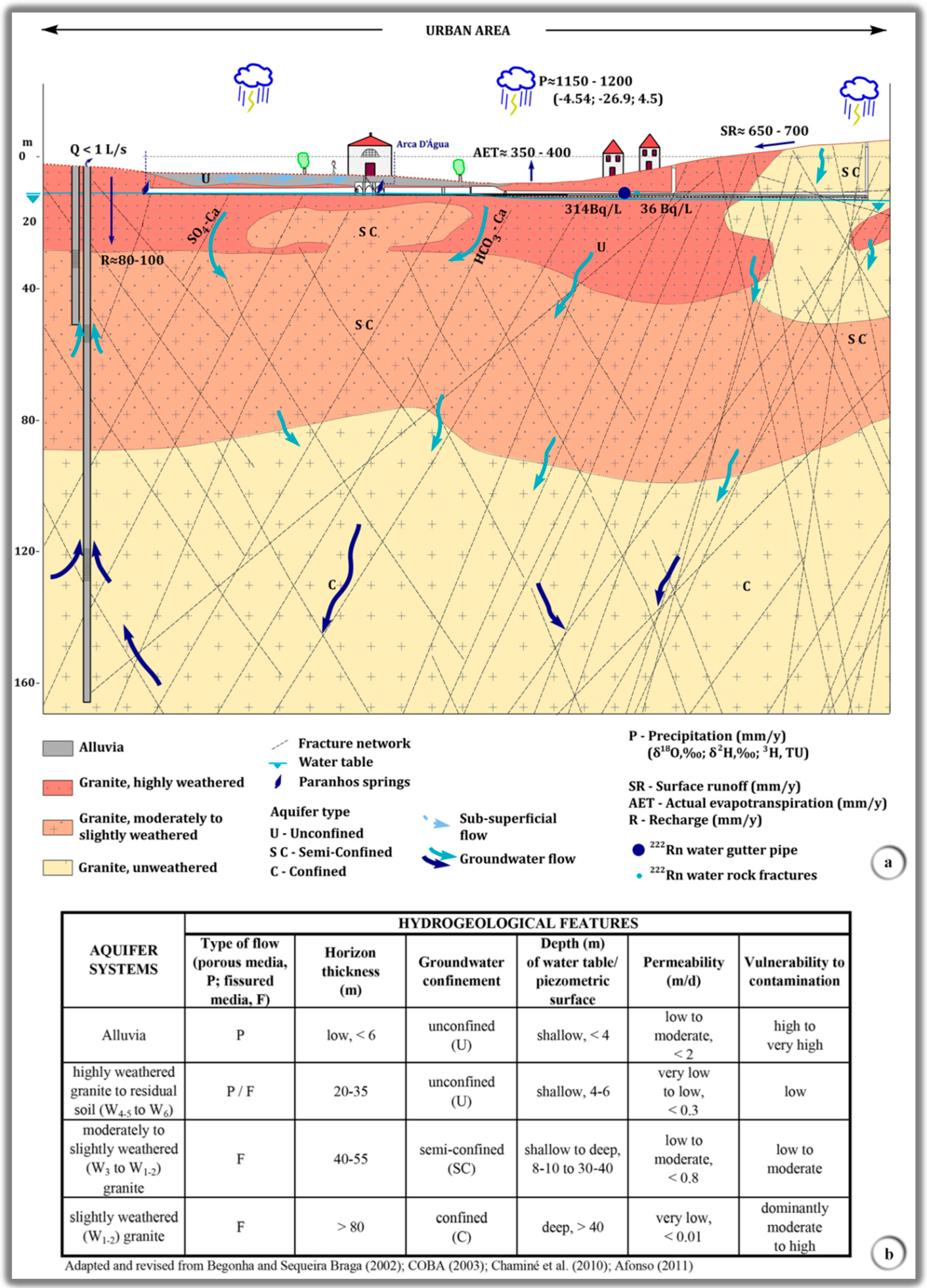
| Methodology | Brief Description | Parameters * | |||||
|---|---|---|---|---|---|---|---|
| D | R | A | S | T | U | ||
| DRASTIC [61] | Point count system model for the evaluation of intrinsic vulnerability. This method considers seven parameters and the vulnerability index is given by the expression: DrDw + RrRw + ArAw + SrSW + TrTW + IrIw + CrCw, where index r refers to the range and w to the assigned weight. Eight vulnerability classes are considered: <80, 80–100, 100–120, 120–140, 140–160, 160–180, 180–200 and >200. | + | + | + | + | + | + |
| GODS [58,59,60] | Rating system model for the evaluation of intrinsic vulnerability. Adaptation of GOD method, where four parameters are considered. The ultimate integrated aquifer vulnerability index is the final product of component indices for these parameters. This method considers five vulnerability classes: 0.0–0.1 (negligible), 0.1–0.3 (low), 0.3–0.5 (moderate), 0.5–0.7 (high) and 0.7–1.0 (extreme). | + | − | + | + | − | + |
| AVI [57] | Rating system model for the evaluation of intrinsic vulnerability. This method considers two parameters, both related to the unsatured zone. The aquifer vulnerability index is given by the hydraulic resistance (c) that results from the product of the two parameters. The method considers five classes: log(c) > 4 (extremely low), 3 < log(c) < 4 (low), 2 < log(c) < 3 (moderate), 1 < log(c) < 2 (high) and log(c) < 1 (extremely high). | + | − | − | − | − | + |
| SINTACS [21,63,64] | Point count system model for the evaluation of intrinsic vulnerability. Derived from DRASTIC, this method uses the same seven parameters as DRASTIC, but the rating and weighting procedure is more flexible. This method provides six strings of multiplier weights that can be used in parallel: normal, severe, seepage, karst, fissured and nitrates. The vulnerability index is given by the expression: SrSw + IrIw + NrNw + TrTw + ArAw + CrCw + SrSw, where r and w have the same meaning of DRASTIC. Six vulnerability classes are considered: 26–80 (very low), 80–105 (low), 105–140 (moderate), 140–186 (high), 186–210 (very high) and 210–260 (extremely high). | + | + | + | + | + | + |
| DRASTIC-Fm (updated from [62]) | Point count system model for the evaluation of intrinsic vulnerability. Modified DRASTIC method that includes an additional eighth parameter: fractured media (Fm). The vulnerability index is given by the expression: DrDw + RrRw + ArAw + SrSW + TrTW + IrIw + CrCw + FmrFmw, where r and w have the same meaning of DRASTIC. The weight for Fm is 3. The same vulnerability classes of DRASTIC are assigned to this method. Fm parameter was derived from the tectonic lineaments density map and grouped into five classes (km of lineaments/km2): <4, 4–8, 8–12, 12–16 and > 16, with ratings of 2, 4, 6, 8 and 10, respectively. | + | + | + | + | + | + |
| * D = depth to groundwater; R = recharge/infiltration; A = aquifer characteristics (lithology, weathering grade, hydraulic conductivity, groundwater confinement, fracturing degree); S = soil media; T = topography/slope; U = unsaturated zone characteristics (lithology, hydraulic conductivity). + parameters included in a given method. − parameters not included in a given method. | |||||||
© 2016 by the authors; licensee MDPI, Basel, Switzerland. This article is an open access article distributed under the terms and conditions of the Creative Commons Attribution (CC-BY) license (http://creativecommons.org/licenses/by/4.0/).
Share and Cite
Afonso, M.J.; Freitas, L.; Pereira, A.; Neves, L.; Guimarães, L.; Guilhermino, L.; Mayer, B.; Rocha, F.; Marques, J.M.; Chaminé, H.I. Environmental Groundwater Vulnerability Assessment in Urban Water Mines (Porto, NW Portugal). Water 2016, 8, 499. https://doi.org/10.3390/w8110499
Afonso MJ, Freitas L, Pereira A, Neves L, Guimarães L, Guilhermino L, Mayer B, Rocha F, Marques JM, Chaminé HI. Environmental Groundwater Vulnerability Assessment in Urban Water Mines (Porto, NW Portugal). Water. 2016; 8(11):499. https://doi.org/10.3390/w8110499
Chicago/Turabian StyleAfonso, Maria José, Liliana Freitas, Alcides Pereira, Luís Neves, Laura Guimarães, Lúcia Guilhermino, Bernhard Mayer, Fernando Rocha, José Manuel Marques, and Helder I. Chaminé. 2016. "Environmental Groundwater Vulnerability Assessment in Urban Water Mines (Porto, NW Portugal)" Water 8, no. 11: 499. https://doi.org/10.3390/w8110499
APA StyleAfonso, M. J., Freitas, L., Pereira, A., Neves, L., Guimarães, L., Guilhermino, L., Mayer, B., Rocha, F., Marques, J. M., & Chaminé, H. I. (2016). Environmental Groundwater Vulnerability Assessment in Urban Water Mines (Porto, NW Portugal). Water, 8(11), 499. https://doi.org/10.3390/w8110499












